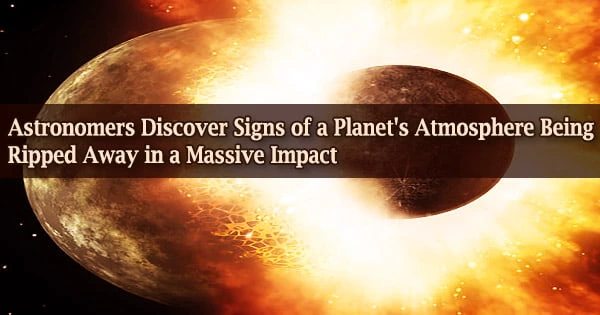As infant bodies crash and unite to produce larger planets, young planetary systems usually go through a lot of growing pains. The Earth and moon in our own solar system are assumed to be the result of such a massive collision. Such collisions are thought to be widespread in early systems, but they have proved difficult to witness near other stars, according to astronomers.
Astronomers from MIT, the National University of Ireland in Galway, Cambridge University, and other institutions have uncovered evidence of a massive impact in a nearby star system, which is only 95 light-years from Earth. The star, known as HD 172555, is roughly 23 million years old, and scientists believe its dust contains evidence of a recent collision.
More evidence of a massive impact around the star has been discovered by an MIT-led study. They calculated that the collision occurred at least 200,000 years ago, at speeds of 10 kilometers per second, or more than 22,000 miles per hour, between a roughly Earth-sized terrestrial planet and a smaller impactor.
They also found gas, indicating that such a fast collision likely swept away a portion of the larger planet’s atmosphere, a dramatic event that would explain the gas and dust seen surrounding the star. The findings, which were published in Nature today, are the first of their type.
“This is the first time we’ve detected this phenomenon, of a stripped protoplanetary atmosphere in a giant impact,” says lead author Tajana Schneiderman, a graduate student in MIT’s Department of Earth, Atmospheric and Planetary Sciences.
“Everyone is interested in observing a giant impact because we expect them to be common, but we don’t have evidence in a lot of systems for it. Now we have additional insight into these dynamics.”
Of all the scenarios, it’s the only one that can explain all the features of the data. In systems of this age, we expect there to be giant impacts, and we expect giant impacts to be really quite common. The timescales work out, the age works out, and the morphological and compositional constraints work out. The only plausible process that could produce carbon monoxide in this system in this context is a giant impact.
Tajana Schneiderman
A clear signal
Because of the unique makeup of its dust, the star HD 172555 has piqued the interest of astronomers. Recent observations have revealed that the star’s dust contains a considerable number of unique materials in grains that are far finer than those expected in a conventional stellar debris disk.
“Because of these two factors, HD 172555 has been thought to be this weird system,” Schneiderman says.
Her colleagues and she speculated on what the gas could disclose about the system’s impact history. They looked at data from ALMA, Chile’s Atacama Large Millimeter Array, which consists of 66 radio telescopes whose spacing may be changed to increase or decrease image resolution. The researchers combed through the ALMA public archive for indications of carbon monoxide surrounding neighboring stars.
“When people want to study gas in debris disks, carbon monoxide is typically the brightest, and thus the easiest to find,” Schneiderman says. “So, we looked at the carbon monoxide data for HD 172555 again because it was an interesting system.”
In the aftermath
The team was able to discover carbon monoxide near the star after a rigorous reanalysis. They discovered that the gas accounted for 20% of the carbon monoxide in Venus’ atmosphere when they measured its quantity.
They also saw that a significant mass of gas was rotating about the star, shockingly near to it, at a distance of around 10 astronomical units, or 10 times the distance between the Earth and the sun.
“The presence of carbon monoxide this close requires some explanation,” Schneiderman says.
This is because carbon monoxide is susceptible to photodissociation, which occurs when photons from a star break down and destroy the molecule. There would be very little carbon monoxide so near to a star at close range. As a result, the team experimented with numerous scenarios to explain the gas’s abundance and close proximity.
They swiftly ruled out the possibility that the gas came from the debris of a freshly created star, as well as the possibility that it came from a nearby belt of icy asteroids. They also investigated the possibility that the gas was released by a swarm of frozen comets rushing in from a far-off asteroid belt similar to our own Kuiper belt.
The facts, on the other hand, didn’t fully fit this scenario. The team’s final thought was that the gas was a leftover of a massive impact.
“Of all the scenarios, it’s the only one that can explain all the features of the data,” Schneiderman says. “In systems of this age, we expect there to be giant impacts, and we expect giant impacts to be really quite common. The timescales work out, the age works out, and the morphological and compositional constraints work out. The only plausible process that could produce carbon monoxide in this system in this context is a giant impact.”
The gas was ejected from a large impact at least 200,000 years ago, according to the researchers, and the star would not have had enough time to entirely destroy it.
The impact was most likely huge, involving two proto-planets roughly the same size as the Earth, based on the quantity of gas. The impact was so powerful that it blew a chunk of one planet’s atmosphere off, resulting in the gas seen by the team today.
“Now there’s a possibility for future work beyond this system,” Schneiderman says. “We are showing that, if you find carbon monoxide in a place and morphology consistent with a giant impact, it provides a new avenue for looking for giant impacts and understanding how debris behaves in the aftermath.”





